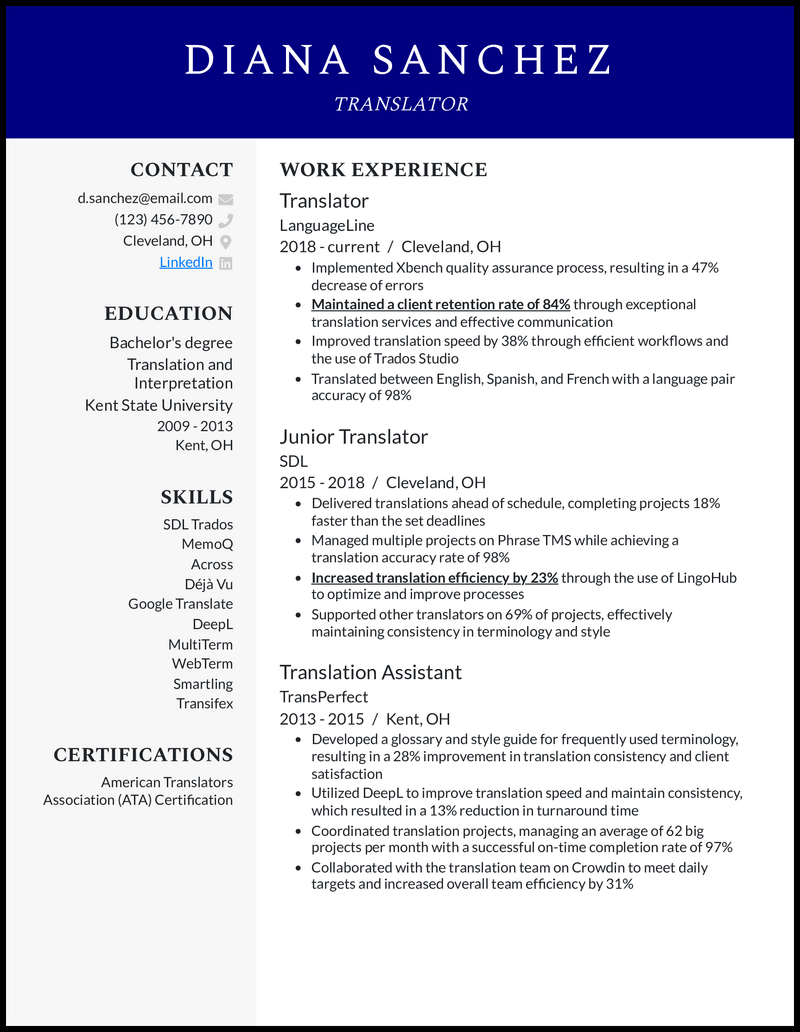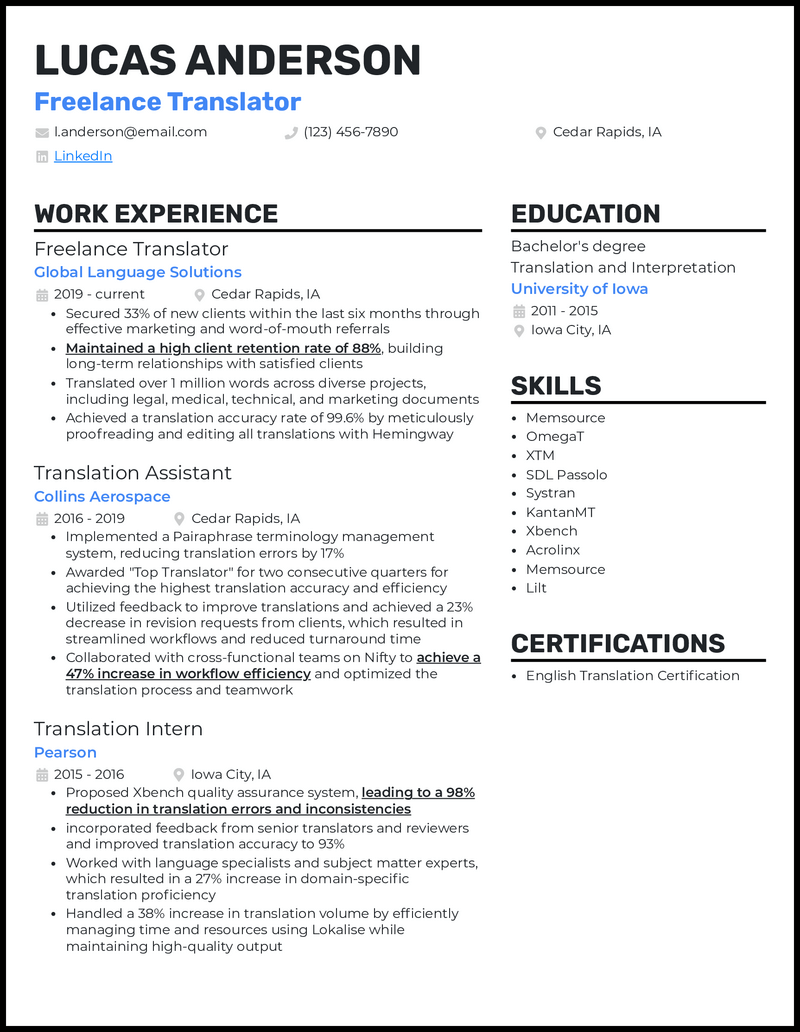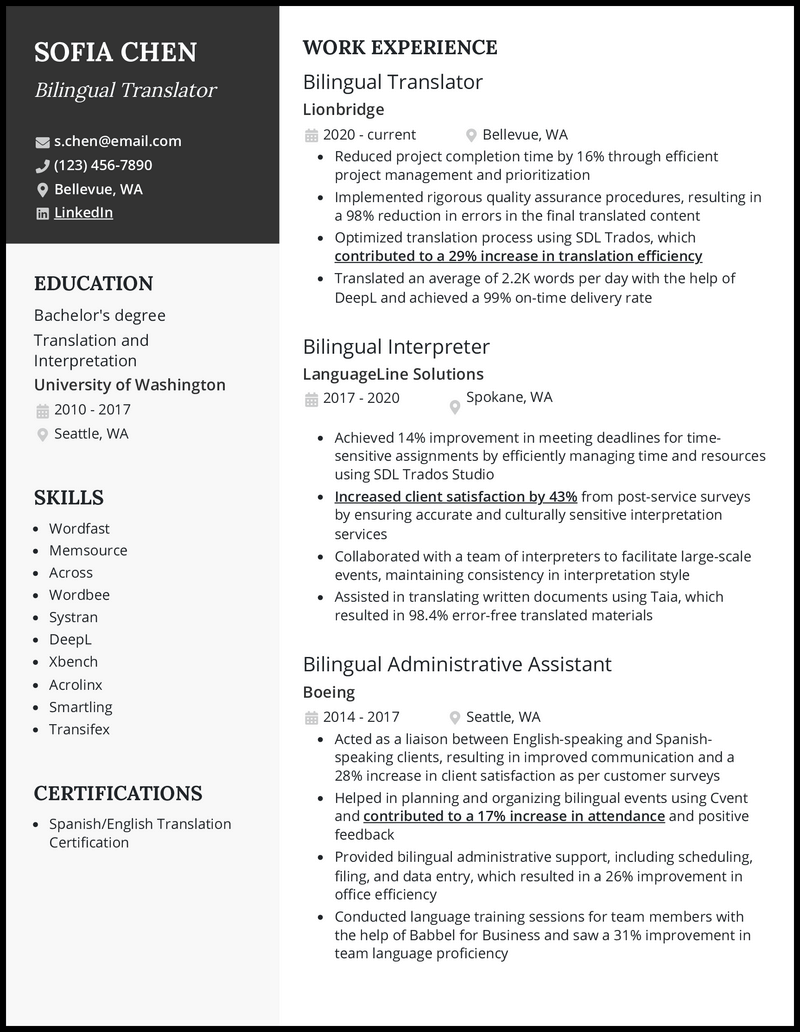In the world of language, translators stand as bridges between cultures and ideas. Your linguistic finesse and worldly insight enable seamless communication, breaking down language barriers that obstruct understanding.
With your knack for nuance, you capture idioms and context, preserving the integrity of messages. However, crafting a resume and writing a cover letter that encapsulate your diverse skills is a different kind of challenge.
No worries, we’re here to help! Our translator resume examples are written by experts and have helped many professionals get the jobs they want most. Just follow our tips and watch your resume transform into something that gets you job interviews.
Why this resume works
- You may be a terrific performer as an individual, but how you function within a team will make or break your ability to be hired. It’s crucial to show your contribution to team projects and how you supported your peers in achieving a bigger goal.
- A perfect highlight to include in your translator resume is how you supported other translators across 69% of projects to achieve accuracy and timely delivery.
Why this resume works
- Concerned that your limited work history might compromise your competitive edge? It’s understandable—we’ve all been there, after all. However, a punchy career objective emphasizing your enthusiasm for the role and alignment with the hiring company’s mission could be your golden ticket.
- Beyond a career objective, your translator no experience resume could benefit from mentions of transferable skills mastered from related roles—say, a part-time language instructor or tutor.
Why this resume works
- Let’s face it: Hiring managers are swapped with beginner translator resumes, and they’ve got to be picky because of the ticking clock. Guess what can make you the apple of their eye? Flaunting job-relevant certifications.
- Take the American Translators Association (ATA) Certification, for instance. It’s like a golden ticket that declares you’ve got a few translation chops, even if your only brush with pertinent experience was a brief internship or a volunteer translator stint.
Why this resume works
- On average, a hiring manager will glance over a resume for just about 8.8 seconds. Now, to ensure none of your qualifications get overlooked, condense everything you have to tell in a single page—it’s faster to digest, after all.
- So, how do you maximize the impact of your one-page medical translator resume? Well, zero in on those career-defining moments, kicking off with your latest role that aligns with the job you’re after. And with a bit of bolding and underlining or italicizing, you can have your key wins catch the recruiter’s eye in a flash.
Why this resume works
- Even the sagest among us falter, for mistakes are intrinsically human. However, avoidable typos and grammatical errors in your Spanish translator resume could be why a chance with your dream company slips right through your fingers.
- You see, linguistic precision forms the foundation of translation. Therefore, a resume with flawless grammar builds your credibility (of course, that demands combing your piece for punctuation errors, misspellings, and awkward phrases).
Why this resume works
- The measure of success in translation jobs is language proficiency and your ability to produce accurate and high-quality work. Is that something you have achieved before? Give that achievement a spotlight in your freelance translator resume and boost your odds of getting the job.
- For instance, mention your almost-perfect score for accuracy and your impressive project turnaround, and recruiters will successfully hire you ahead of everyone else.
Why this resume works
- In bilingual interpretation, you will find yourself in culturally sensitive situations. How you ensure that you do not cross the line in such cases proves your holistic competencies and suitability for the job.
- Ensure you’re ahead of the next candidate by including your accuracy numbers for culturally sensitive content in your bilingual translator resume.
Related resume examples
Adapt Your Translator Resume to Impress the Recruiters

Your translator resume is a canvas for showcasing your language prowess, so make every skill count. The trick is to pinpoint the ones that align with the job and your expertise. Skip the bland stuff like “good communicator” and dive into specifics.
Since translation is both an art and a science, emphasize your linguistic talents, fluency in languages, and familiarity with translation software and tools. Don’t shy away from listing your knowledge of cultural nuances and adaptation, especially for less technical roles.
For more tech-oriented jobs, focus on specialized software and localization tools, and use plenty of industry-specific terminology. Soft skills? Save those for your work experience section, unless you’re rocking a leadership role.
Need a few pointers?
15 best/top/popular translator skills
- SDL Trados Studio
- MemoQ
- Wordfast
- OmegaT
- Memsource
- Smartling
- Transifex
- Lokalise
- DeepL
- Trello
- Microsoft Office
- Google Workspace
- Language Proficiency
- Interpretation
- PhraseApp

Your translator work experience bullet points
Your work experience section is a chance to shine a spotlight on your achievements rather than simply recounting your daily tasks. Whether you’re best at bridging cultural divides with in-person interpretation, enhancing global communication, or ensuring flawless language adaptation, your accomplishments take center stage.
Highlight specific wins—such as surpassing project deadlines, achieving consistent quality ratings, or successfully handling complex legal documents. Quantify your impact by mentioning metrics like project completion rates, client satisfaction scores, or word count efficiency.
You can also use active verbs and dynamic language to detail your accomplishments, showcasing how your expertise has directly contributed to the efficiency and effectiveness of your team or organization.
- Mention that you consistently deliver projects ahead of schedule, showcasing your efficiency and time management skills.
- Provide insights into your productivity by mentioning the average number of words you translate per day or per hour.
- Include client satisfaction scores or feedback you’ve received for your translations to highlight your communication skills, accuracy, and ability to meet clients’ expectations.
- Show the percentage of error-free translations you’ve delivered or your involvement in implementing quality assurance processes.
See what we mean?
- Reduced project completion time by 16% through efficient project management and prioritization
- Implemented rigorous quality assurance procedures, resulting in a 98% reduction in errors in the final translated content
- Maintained a high client retention rate of 88%, building long-term relationships with satisfied clients
- Translated between English, Spanish, and French with a language pair accuracy of 98%
9 active verbs to start your translator work experience bullet points
- Enhanced
- Collaborated
- Optimized
- Adapted
- Improved
- Coordinated
- Researched
- Facilitated
- Innovated
3 Tips for Writing a Translator Resume Without Much Experience
- Embrace your language journey
- Even with limited professional experience, your language skills matter. Highlight any translation projects you’ve tackled during your studies or personal time. Discuss how you’ve effectively translated documents, websites, or even assisted peers with language-related tasks.
- Showcase relevant education
- If you’re just starting, emphasize relevant coursework and academic achievements. List language-focused classes, cultural studies, or linguistics courses that have enhanced your translation skills. Include any academic awards or commendations, such as scholarships or language proficiency certificates.
- Leverage internships and extracurriculars
- If you’ve participated in language-related internships, volunteer work, or extracurricular activities, they’re worth highlighting. Describe how these experiences exposed you to real-world translation challenges and allowed you to apply your language skills in a practical setting.
3 Tips for Writing a Translator Resume as a Seasoned Expert
- Highlight your translation specializations
- If you’ve specialized in specific types of translation, such as legal, medical, technical, or literary, emphasize these areas in your resume. Focus on projects, coursework, or hands-on experience related to these niches.
- Optimize for ATS compatibility
- Many employers use applicant tracking systems (ATS) to screen resumes. Make a resume with relevant keywords and phrases from the job description. Highlight your language skills, software proficiencies, and specialized knowledge. This enhances your chances of passing through ATS filters and getting noticed by human reviewers.
- Showcase relevant certifications
- Include any language-related certifications you’ve earned, such as translation certifications, language proficiency tests, or localization training. These certifications validate your skills and dedication.
Absolutely! Metrics add oomph to your resume. Focus on stats that show off your skills. Mention things like average daily word count, on-time project deliveries, and client satisfaction ratings.
There’s no need to drown recruiters in a sea of languages. Showcase the languages you’re seriously solid in and the ones that match the job description. If you’ve got less common languages down, those are golden to mention, too. Just keep it real and relevant to the gig.
Sure thing, but tread lightly. Creative resume templates can be useful, but they might trip up the ATS bots. If you’re applying directly, they could make you stand out, but when in doubt, a clean and professional format is the safer bet.




![7 Translator Resume Examples [& Templates]](https://beamjobs.wpenginepowered.com/wp-content/uploads/2023/08/translator-resume-example.png)







